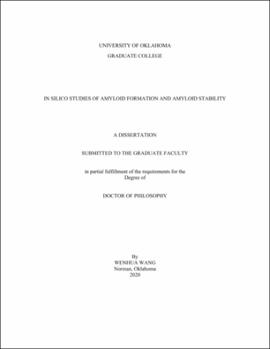| dc.description.abstract | The term “Amyloid” describes the precursor proteins misfolded and aggregated into fibril-like structures that are built by cross β-sheet subunit. The disease caused by depositing amyloid fibril in tissues and organs is called amyloidosis. Amyloidosis can not only damage tissues and organs but also could lead to death. More than thirty amyloidoses have been observed in human body, these amyloidoses can be classified to mainly two types, local and systemic amyloidoses. One well-known local amyloidosis, amyloid β amyloidosis (Aβ amyloidosis) is caused by its precursor protein amyloid β (Aβ) misfolding and aggregation, and Aβ amyloidosis leads to Alzheimer’s Disease (AD). Patients who developed AD suffer from the neurodegenerative disorder and losing memory. On the other hand, precursor protein serum amyloid A (SAA) can cause so-called systemic amyloidosis, specifically amyloid A amyloidosis (AA amyloidosis). AA amyloidosis can cause damage in tissues and organs non-localized in the human body, such as heart, spleen, kidney, and liver. The mechanisms for amyloid fibril formation and the difference in toxicity among species for both Aβ and SAA remain unclear, especially missing is the atomic detail of structural and dynamic information. In this thesis, molecular dynamics (MD) and other enhanced sampling methods are applied to probe the structural dynamics for Aβ and SAA systems. Specifically, the study in chapter 3 for Aβ derives 1) the critical size, 2) the important role of last two hydrophobic residues on C-terminus to stabilize structures and 3) potential packing patterns to form two-fold structures, for the newly found S-shaped Aβ fibril structure. As for SAA, our study of the N-terminal fragments revealed that the key salt-bridge interaction between residues 1R and 9E controls the misfolding and aggregation of the amyloidogenic region, the dissolving of the salt-bridge can initialize the amyloid formation process, see details in chapter 4. Furthermore, our simulations of hexamer and monomer fragments and full-sized SAA protein suggested that SAA amyloid formation happens after the failure of a downregulation mechanism. The downregulation mechanism is proposed based on the following two observations. First, the difference in stability between full-sized hexamer and the hexamer built from shorter fragments, second, different structural properties between variant monomer motifs, third, different pH conditions, details can be seen in chapter 5. Recently, a high resolution SAA fibril structure has been resolved via Cryo-EM. In order to understand of SAA fibril formation better, we study the thermodynamic stability of the fibril via molecular dynamics simulations. Our preliminary results in chapter 6 reveal that SAA fibril formation starts from monomers stacking into meta-stable one-fold subunit and then packing into stable fibril with two-fold symmetry. The two-fold two-layers system is the minimum size to maintain the fibril stable. The meta-stable structure can be stabilized under acidic conditions, it is consisted with our previous observation that low pH is critical to initialize SAA mis-folding and aggregation. We also discussed the roles of N-terminal amyloidogenic region and C-terminal disordered region play in SAA fibril formation. The data and results generated from our studies (chapters 3 - 6) reveal the posterities of amyloids and provide physical explanations at the atomic level, also this information of precursor protein downregulation, amyloid formation, and toxicity can be generalized to understand different type of amyloidoses and provide insights into future studies. | en_US |

